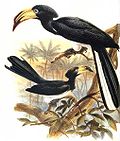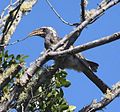Lophoceros
 From Wikipedia the free encyclopedia
From Wikipedia the free encyclopedia
| Lophoceros | |
|---|---|
 | |
| Crowned hornbill, Lophoceros alboterminatus | |
| Scientific classification | |
| Domain: | Eukaryota |
| Kingdom: | Animalia |
| Phylum: | Chordata |
| Class: | Aves |
| Order: | Bucerotiformes |
| Family: | Bucerotidae |
| Genus: | Lophoceros Hemprich & Ehrenberg, 1833 |
| Type species | |
| Buceros nusutus (Linnaeus, 1766) | |
| Species | |
| See text. | |
Lophoceros is a genus of birds in the hornbill family, Bucerotidae, which are native to Africa.
Taxonomy
[edit]The genus Lophoceros was introduced in 1833 by the German naturalists Wilhelm Hemprich and Christian Gottfried Ehrenberg to accommodate Buceros, Lophoceros, forskålii.[1] This is now considered as a junior synonym of the nominate subspecies of the African grey hornbill (Lophoceros nasutus nasutus).[2] The genus name combines the Ancient Greek lophos meaning "crest" with kerōs meaning "horn".[3]
The species now placed in this genus were formerly included in the genus Tockus. A molecular phylogenetic study published in 2013 found that Tockus was divided by a deep phylogenetic split into two major groups. The genus Lophoceros was therefore resurrected to contain one of these groups.[4][5]
Species
[edit]The genus contains 8 species:[5]
| Image | Scientific name | Common Name | Distribution |
|---|---|---|---|
 | Lophoceros alboterminatus | Crowned hornbill | northeastern Africa |
 | Lophoceros bradfieldi | Bradfield's hornbill | northern Botswana, southern Angola and eastern Zimbabwe |
 | Lophoceros fasciatus | Congo pied hornbill | Nigeria to northern Angola and Uganda |
 | Lophoceros semifasciatus | West African pied hornbill | Senegal and Gambia to southern Nigeria |
 | Lophoceros hemprichii | Hemprich's hornbill | Djibouti, Eritrea, Ethiopia, Kenya, Somalia, South Sudan, and Uganda |
 | Lophoceros pallidirostris | Pale-billed hornbill | Angola, DRC, Kenya, Malawi, Mozambique, Tanzania, and Zambia. |
 | Lophoceros nasutus | African grey hornbill | Sub-Saharan Africa and into Arabia |
 | Lophoceros camurus | Red-billed dwarf hornbill | Angola, Benin, Cameroon, Central African Republic, Republic of the Congo, Democratic Republic of the Congo, Ivory Coast, Equatorial Guinea, Gabon, Ghana, Guinea, Liberia, Nigeria, Sierra Leone, South Sudan, and Uganda. |
References
[edit]- ^ Hemprich, Wilhelm; Ehrenberg, Christian Gottfried (1828). Symbolae physicae (in Latin). Vol. 1: Avium Part 1. Berolini [Berlin]: Ex Officina Academica. Pages are not numbered. Text and Note 8. Although the year 1828 is printed on the title page, the volume was not published until 1833. See: Dickinson, E.C.; Overstreet, L.K.; Dowsett, R.J.; Bruce, M.D. (2011). Priority! The Dating of Scientific Names in Ornithology: a Directory to the literature and its reviewers. Northampton, UK: Aves Press. pp. 91–92. ISBN 978-0-9568611-1-5.
- ^ Dickinson, E.C.; Remsen, J.V. Jr., eds. (2013). The Howard & Moore Complete Checklist of the Birds of the World. Vol. 1: Non-passerines (4th ed.). Eastbourne, UK: Aves Press. p. 283, Note 8. ISBN 978-0-9568611-0-8.
- ^ Jobling, James A. (2010). The Helm Dictionary of Scientific Bird Names. London: Christopher Helm. p. 230. ISBN 978-1-4081-2501-4.
- ^ Gonzalez, J.-C.T.; Sheldon, B.C.; Collar, N.J.; Tobias, J.A. (2013). "A comprehensive molecular phylogeny for the hornbills (Aves: Bucerotidae)". Molecular Phylogenetics and Evolution. 67 (2): 468–483. doi:10.1016/j.ympev.2013.02.012. PMID 23438388. See also the correction: Gonzalez, J.-C.T.; Sheldon, B.C.; Collar, N.J.; Tobias, J.A. (2013). "Corrigendum to "A comprehensive molecular phylogeny for the hornbills (Aves: Bucerotidae)" [Mol. Phylogenet. Evol. 67 (2013) 468–483]". Molecular Phylogenetics and Evolution. 68 (3): 715. doi:10.1016/j.ympev.2013.05.008.
- ^ a b Gill, Frank; Donsker, David; Rasmussen, Pamela, eds. (January 2022). "Mousebirds, Cuckoo Roller, trogons, hoopoes, hornbills". IOC World Bird List Version 12.1. International Ornithologists' Union. Retrieved 10 June 2022.







